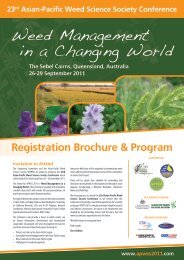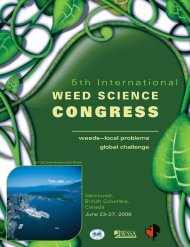PARAQUAT
PARAQUAT
PARAQUAT
You also want an ePaper? Increase the reach of your titles
YUMPU automatically turns print PDFs into web optimized ePapers that Google loves.
showing a decrease in macrophages (cells that<br />
destroy bacteria, viruses, and tumour cells) as<br />
a result of exposure to paraquat (Styles 1974).<br />
Another study, of chronic exposure of rats to low<br />
levels of paraquat, showed suppression of the T<br />
lymphocytes (Caroleo et al 1996).<br />
Paraquat has also been found to increase the<br />
release of histamine from mast cells in rats and<br />
therefore can exacerbate allergic diseases (Sato<br />
et al 1998).<br />
Recently paraquat has been demonstrated to<br />
cause immune-based inflammatory effects in<br />
umbilical cells (Yu & Nie 2010).<br />
At high doses it suppresses both the cellular and<br />
humoral activity of the immune system of rats<br />
(Riahi et al 2010).<br />
2.5 Toxic interactions<br />
The addition of copper enhanced the toxicity of<br />
paraquat to the malarial parasite Plasmodium<br />
falciparum (Marva et al 1991) and the bacterium<br />
E. coli (Kohen et al 1985). Iron also enhanced<br />
toxicity of paraquat to E. coli (Korbashi et al<br />
1986).<br />
Prior exposure to paraquat enhanced the<br />
inhibition of brain acetyl cholinesterase by the<br />
insecticide fenthion (Wijeyaratne & Pathiratne<br />
2006).<br />
2.6 People at heightened risk<br />
People at heightened risk from exposure to<br />
paraquat include those with impaired pulmonary<br />
function (HSDB 2009); those with seleniumdeficient<br />
diets, as selenium defi ciency increases<br />
the toxicity and lethality of paraquat (Glass et al<br />
1985); and children.<br />
3. Human Health Effects<br />
3.1 Exposure guidelines<br />
• Acceptable Daily Intake (ADI) = 0.004 mg/<br />
kg/day (EC 2003)<br />
• Acceptable Operator Exposure Level (AOEL)<br />
(long term) = 0.0004 mg/kg/day (EC 2003)<br />
• Acceptable Operator Exposure Level (AOEL)<br />
(short term) = 0.0005 mg/kg/day (EC 2003)<br />
• Acute Reference Dose = 0.005 mg/kg/day<br />
(EC 2003)<br />
• Child Reference Dose (draft) = 7 x 10 -5 mg/<br />
kg/day (CAL EPA 2010)<br />
As little as a teaspoon, or a mouthful, of a 20%<br />
solution may be fatal – equivalent of 17 mg/kg<br />
(Wesseling et al 1997; Dinis-Oliviera et al 2006).<br />
3.2 Health effects<br />
Acute effects<br />
Severe paraquat poisoning is fatal; death may<br />
be very rapid or delayed up to several weeks.<br />
The main target organ of paraquat poisoning<br />
is the lung, but paraquat is also distributed to<br />
the heart, liver, and kidney. The brain is now<br />
recognised as another target organ: after a<br />
single injection paraquat is clearly seen in<br />
the brain (Cal EPA 2010). Systemic paraquat<br />
poisoning is characterised by burns to the<br />
mouth, throat, oesophagus, and stomach<br />
(when ingested); acute respiratory distress;<br />
and multi-organ failure. Less frequently there<br />
may be affects on the central nervous system;<br />
adrenal glands; kidney; heart; and muscles<br />
including necrosis, excitability, convulsions, lack<br />
of coordination; and coma. There may be loss<br />
of appetite, thirst, nausea, vomiting, abdominal<br />
pain, diarrhoea, giddiness, headache, fever,<br />
muscle pain, peripheral burning sensations,<br />
lethargy, shortness of breath, rapid heartbeat,<br />
sore and congested lungs, coughing up of frothy<br />
sputum, cerebral oedema and brain damage,<br />
and renal failure. Pancreatitis may cause severe<br />
abdominal pain, and liver damage may cause<br />
jaundice. Death is by respiratory failure (Grant<br />
et al 1980; Extoxnet 1996; Reigart & Roberts<br />
1999; Wesseling et al 2001a; Gawarammana &<br />
Dawson 2010).<br />
Clinical reports identify acute lung injury and<br />
pulmonary hypertension; leucocytosis; metabolic<br />
acidosis; increased levels of blood amylase,<br />
glucose, and creatinine (Jun & Kang 2009);<br />
enlarged heart (Im et al 1991); acute kidney<br />
injury (Kim et al 2009); and generalized oedema,<br />
19




